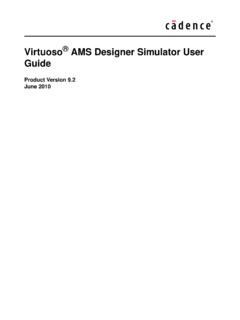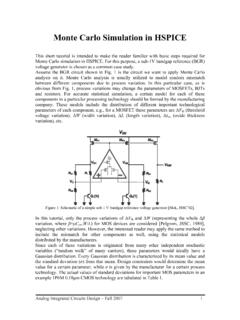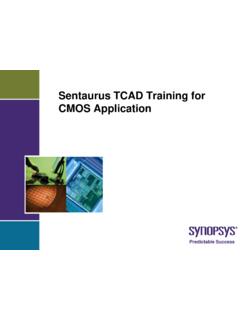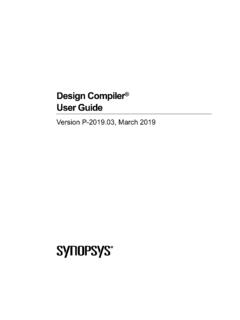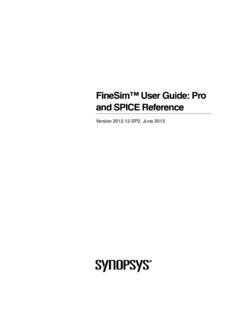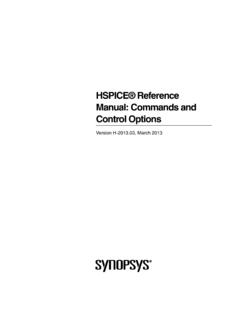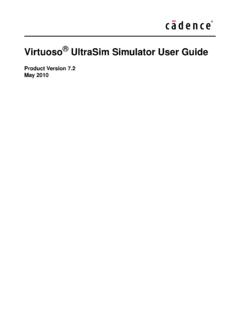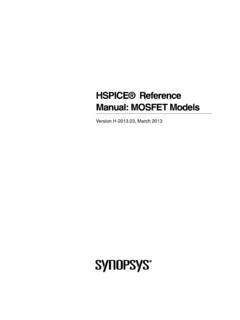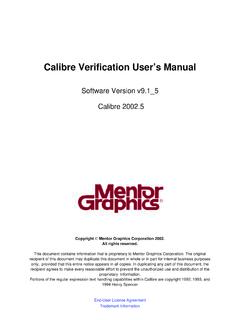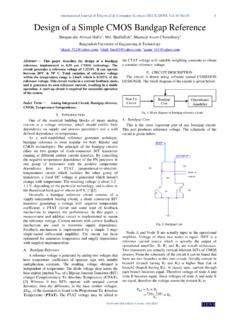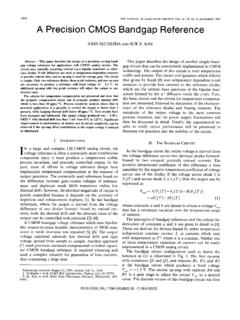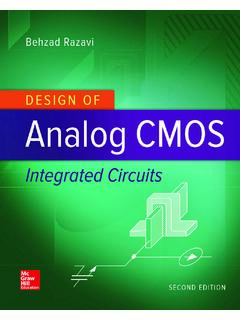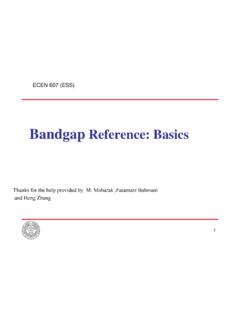Transcription of CMOS Analog Circuit Design
1 Third EditionCMOS Analog Circuit DesignPhillip E. AllenProfessor Emeritus, Georgia Institute of TechnologyDouglas R. HolbergConsultantNewYork OxfordOXFORD UNIVERSITY PRESSO xford University Press, Inc., publishes works that further Oxford University sobjective of excellence in research, scholarship, and New YorkAuckland Cape Town Dar es Salaam Hong Kong KarachiKuala Lumpur Madrid Melbourne Mexico City NairobiNew Delhi Shanghai Taipei TorontoWith offices inArgentina Austria Brazil Chile Czech Republic France GreeceGuatemala Hungary Italy Japan Poland Portugal SingaporeSouth Korea Switzerland Thailand Turkey Ukraine VietnamCopyright 2012, 2002 by Oxford University Press, titles covered by Section 112 of the Higher EducationOpportunity Act, please visit for the latestinformation about pricing and alternate by Oxford University Press, Madison Avenue, New York, NY is a registered trademark of Oxford University PressAll rights reserved.
2 No part of this publication may be reproduced,stored in a retrieval system, or transmitted, in any form or by any means,electronic, mechanical, photocopying, recording, or otherwise,without the prior permission of Oxford University 978-0-19-976507-2 Printing number:987654321 Printed in the United States of Americaon acid-free paperxiPREFACEThe objective of the third edition of this book continues to be to teach the Design ofCMOS Analog circuits. The teaching of Design reaches far beyond giving examples ofcircuits and showing analysis methods. It includes knowing the necessary fundamentalsand background and applying them in a hierarchical manner that the novice can of most importance is to teach the concepts of designing Analog integrated circuitsin the context of cmos technology. These concepts enable the reader to understand the oper-ation of an Analog cmos Circuit and to know how to change its performance.
3 In today's com-puter-oriented thinking, it is crucial to maintain personal control of a Design , to know whatto expect, and to discern when simulation results may be misleading. As integrated circuitsbecome more complex, it is crucial to know how the Circuit works. Simulating a circuitwithout the understanding of how it works can lead to disastrous does the reader acquire the knowledge of how a Circuit works? The answer to thisquestion has been the driving motivation of this text beginning with the first edition. Thereare several important steps in this process. The first is to learn to analyze the Circuit . Thisanalysis should produce simple results that can be understood and reapplied in different cir-cumstances. The second is to view Analog integrated- Circuit Design from a hierarchical view-point. This means that the designer is able to visualize how subcircuits are used to formcircuits, how simple circuits are used to build complex circuits, and so forth.
4 The third stepis to set forth procedures that will help the new designer come up with working designs. Thishas resulted in the inclusion of many Design recipes, which became popular with the firstand second editions and have been enlarged in the third edition. It is important that thedesigner realize that there are simply three outputs of the electrical Design of cmos analogcircuits. They are (1) a schematic of the Circuit , (2) dc currents, and (3) W/L ratios andcomponent values. Most Design flows or recipes can be organized around this viewpointvery EditionsThe first edition of cmos Analog Circuit Design published in 1987 was the first to presenta hierarchical approach to the Design of cmos Analog circuits. Since its introduction, it hasxiiPREFACE found extensive use in industry and classrooms worldwide. Of course, technology advancesand methodologies mature, making it clear that the first edition needed second edition resulted from a unique blending of industry and academia.
5 Betweenthe period of the first and second editions (15 years), over 50 short courses were taught fromthe first edition to over 1500 engineers worldwide. In these short courses, the engineersdemanded to understand the concepts and insights to designing Analog cmos circuits, andmany of the responses to those demands were included in the second edition. In addition tothe industrial input to the second edition, the authors have taught this material at GeorgiaInstitute of Technology and the University of Texas at Austin. This experience providedinsight that was included in the second edition from the viewpoint of students and their ques-tions. Moreover, the academic application of this material has resulted in a large body of newproblems that were given as tests and included in the second EditionThe third edition has focused on cleaning up the material and removing that which is not problems that were not effective have been removed and replaced by better prob-lems.
6 This edition has introduced the idea of Design problems. These problems give thedesired specifications and a score for grading the problem. The reader is to do the Design byhand and then use the computer to simulate the performance and extract the score. These aregreat vehicles for teaching the trade-off of optimizing the score versus the time spent. Also inthis edition, answers to selected problems are found at the back of the changes to the third edition are as follows. The technology in Chapter 2 has been updated and a new appendix created to givedetails on layout (Appendix B). In Chapter 3 the large-signal MOS model has been extended to include velocitysaturation. In Chapter 4, the bandgap section has been updated and completely rewritten. The cascode op amps in Chapter 6 have been updated and the enhanced-gain techniqueused to create op amps with ultra large voltage gains.
7 In Chapter 7, the differential-in, differential-out op amps have been updated and thematerial on output common-mode feedback expanded. Chapter 9, on switched capacitor circuits, was removed and condensed into Appendix E. A Design illustration was presented in Section to show the steps in designing anopen-loop, buffered, sample-and-hold Circuit . Also included in Chapter 9 at the conclusion is the website to an Excel spreadsheet thathas all published ADC converters from 1997 through 2010. This information isextremely useful for understanding the trends in converters. Design problems have been introduced. These problems give the desired specificationsand a score for grading the problem. The reader is to do the Design by hand and thenuse the computer to simulate the performance and extract the score. These are greatvehicles for teaching the trade-off of optimizing the score versus the time spent.
8 Readers of the previous editions have requested answers to the problems. In this edi-tion, answers to selected problems are found at the back of the of the ChaptersUnchanged from the second edition, the hierarchical organization of the third edition is illus-trated in Table Chapter 1 presents the material necessary to introduce cmos analogcircuit Design . This chapter gives an overview of the subject of cmos Analog Circuit Design ,defines notation and convention, makes a brief survey of Analog signal processing, and givesan example of Analog cmos Design with emphasis on the hierarchical aspect of the 2 and 3 form the basis for Analog cmos Design by covering the subjects of cmos technology and modeling. Chapter 2 reviews cmos technology as applied to MOS devices,pn junctions, passive components compatible with cmos technology, and other componentssuch as the lateral and substrate BJT and latch-up.
9 Chapter 3 introduces the key subject ofmodeling, which is used throughout the remainder of the text to predict the performance ofCMOS circuits. The focus of this chapter is to introduce a model that is good enough to pre-dict the performance of a cmos Circuit to within 10% to 20% and will allow the Design -er insight and understanding. Computer simulation can be used to more exactly model thecircuits but will not give any direct insight or understanding of the Circuit . The models in thischapter include the MOSFET large-signal and small-signal models, including frequencydependence. In addition, how to model the noise and temperature dependence of MOSFET sand compatible passive elements is shown. This chapter also discusses computer simulationmodels. This topic is far too complex for the scope of this book, but some of the basic ideasare presented so that the reader can appreciate computer simulation models.
10 Other models forthe subthreshold operation are presented along with how to use SPICE for computer simula-tion of MOSFET 4 and 5 present the topics of subcircuits and amplifiers that will be used to designmore complex Analog circuits, such as an op amp. Chapter 4 covers the use of the MOSFETas a switch followed by the MOS diode or active resistor. The key subcircuits of currentsinks/sources and current mirrors are presented next. These subcircuits permit the illustrationof important Design concepts such as negative feedback, Design trade-offs, and matching prin-ciples. Finally, this chapter presents independent voltage and current references and thebandgap voltage reference. These references attempt to provide a voltage or current that isindependent of power supply and temperature. Chapter 5 develops various types of amplifiers are characterized from their large-signal and small-signal performance,including noise and bandwidth where appropriate.
